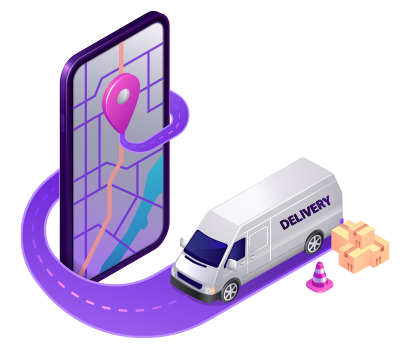Did you notice that in the last 4-5 months, there is a significant increase in the delivery services of Ubereats, Amazon, Esty or other local stores? Like every second day, you’ll see a delivery boy with a parcel hunting for the house number. We already had them. But there is a rise in frequency. Your neighborhood elderly couple who wouldn’t check WhatsApp might have started ordering medicines online.
The reason for the sudden rise is obvious. Because of social distance, people are not coming out of their houses. This new way of life has led people to avail the services by on-demand apps from the safety of their drawing rooms. Let’s have a glance at some figures that indicate growing progress in the on-demand delivery app services.
According to the PwC report, the market for On-demand delivery apps and websites will reach a significant value of $335Billion by the year 2025.
- On-demand food delivery market hit $161.74 Billion by 2023.
- The On-demand delivery apps economy is prompting over 22.4 million users annually to spend around $57.6 billion.
- 60% of the US users are ready to pay extra to get the material delivered to their place.
From the above points, one thing is clear that the future of On-Demand Delivery apps is promising and shows no sign of decline. Adding to this, are our prime customers- the ‘Netflix and Chill’ generation who are spending a good amount on smart delivery apps. Reports cite that in 3 out of 5 cases Millennials order food delivery or visit restaurants for takeout.
If you have a business idea in mind and wish to build an On-Demand Delivery app, then you are at the right place. This post is to derive a complete end-to-end delivery management solution for a variety of industries to grow, streamline, and optimize the online sales funnels and provide efficient deliveries to customers.
On-Demand Delivery App for Various Industries
Customers are demanding almost all kinds of services from the comfort of their home. Businesses that offer the following services are seeing a surge in demand:
Grocery Delivery Apps
The shift to online grocery shopping is leading to an increase in demand for on demand grocery delivery apps like Walmart Grocery, Instacart, Shipt, Instashop. The forecast from SuperMarket News, grocery apps have seen a 98% increase in the average number of daily downloads in February. Have a look at the below image that shows the daily downloads of grocery delivery apps in the USA.
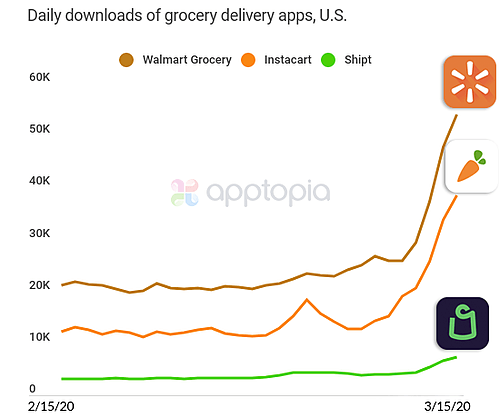
Healthcare Apps
During the pandemic, the healthcare sector has played a major role in saving lives. Medicine delivery apps by providing on-time access to medical supplies have been a blessing. According to a forecast from Statista, this market will generate higher than 33.7% revenue.
Online pharmacy companies like Netmeds, 1mg, and PharmEasy, have seen a demand surge during the Coronavirus outbreak. “The ongoing pandemic has left people helpless, with new AI developed by our team. We can ensure the safe delivery of medicines to our customers”- Pradeep Dadha, Founder & CEO of Netmeds.
Food Delivery Apps
As bars and restaurants closed their doors, online food delivery was the only option. Many food businesses shifted online to serve customers in the best possible way. We saw a phenomenal increase in food delivery apps like UberEats, DoorDash, Swiggy, Zomato, and more. Uber claims a 10-fold increase in new signups as many restaurants shift to take-out only.
The below image will make the scenario clear.
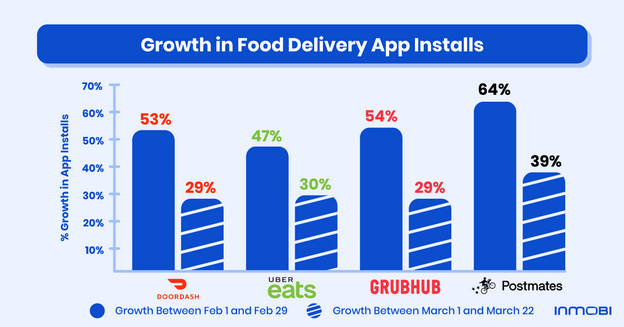
Fashion and Apparel Delivery Apps
Fashion and apparel brands who have a strong online presence have witnessed a bump in sales. Online retailers by offering doorstep delivery are ahead in the market satisfying their customers demand for new clothes and accessories.
Asos, an online fashion retailer based in the UK, said sales in the four months through June 30 climbed 10% despite the pandemic.
Vestiaire Collective, a resale marketplace for luxury fashion online that’s based in France but sells globally, said the number of items customers bought on its site jumped 119% in May compared to last year.
No matter what domain you choose, having a smart delivery app will enable you to provide the best customer experience and will open doors for growth for your business.
A Step by Step Guide to Developing an On-Demand Delivery App
Step 1: Get an Idea
If you already have a specific service in mind then good for you! If you do not have, we suggest opening your laptop and start searching for what’s trending. Like we discussed earlier, food, grocery, and fashion are currently trending. You want to start selling homemade cookies or you wish to explore the fashion market that’s up to you. Before choosing a domain make sure that you are passionate about that thing and that there is a demand for it.
Step 2: Work on the Idea
Once you decide the genre of the On-Demand Delivery app, the next step is to do a market analysis and identify the target audience. You can not target everybody. Especially if you are beginning with a business, focusing on a specific target market and target audience is effective, efficient, and affordable.
Analyze the market. See what is working and what is not. Check out who your competitors are targeting. If you are planning to create an on-demand food delivery app, be very specific about the target market. Do you want to deliver bakery items, healthy wraps, or vegan meals? This will help you drive a specific audience to your business. The trick to identifying a target audience is by considering demographics like age, location, gender, income and considering psychographics like personality, values, lifestyle, interests.
Read articles, look for statistics and survey results, note down what you are aiming for and you are good to go.
Step 3: Decide a Business Model
The word might seem huge and fancy but it’s not. In the most basic sense, a business model is a business’s strategy for profitably doing business. It includes information like products or services, target markets, and any anticipated expenses. You can choose from the 5 popular models for on-demand delivery apps:
- A peer-to-peer model, the person doing the delivery exchanges products or services directly with the customer. eBay, for example.
- Business to consumer model. For instance, in Starbucks mobile app; you can directly place an order, pay in person or get the delivery at your doorstep.
- A three-sided business model like UberEats that connects the driver, the restaurant, and the customer.
- Subscription model where delivery companies offer to make an unlimited number of deliveries for a fixed monthly price.
- Business-to-business model where brands cater to businesses rather than individuals. Catering for offices, for example.
You have a business idea, a business model and a target market. The next step is deciding a unique selling point. What is it that makes your brand unique? A USP will not just set you apart from your competitors but it will make your customers genuinely fall in love with you because you are giving them something that’s different. The following example might help you if you are looking for inspiration.
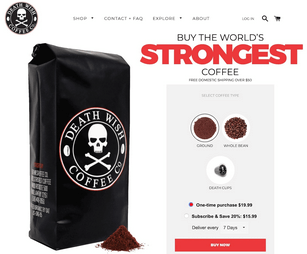
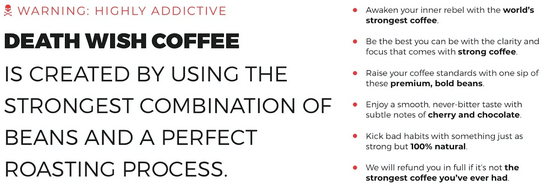
Death Wish Coffee is an excellent example of developing a product based on a USP. It promises its customers the world’s strongest coffee or their money back.
Step 4: Do Not Forget the Budget
‘How much will it cost’? is a pertinent question. Not answering it can result in you having to say bye-bye to your dream app because you cannot meet the expenses. Therefore, planning the budget beforehand is a good precaution. Ask yourself how much you have and how much more you need. Consciously plan your budget to make the right decisions for the growth of your business. A successful budget plan for building an app will include the following basic things:
- License, hosting fee
- Development cost
- Marketing cost
- Design expenses
- Cost of materials, resources, packaging, etc.
Step 5: An Online Shift
Your business plan now needs an online presence- a website. You might argue that an on-demand delivery app is good enough for your business why you need a website. There are plenty of benefits of having an eCommerce website. First, it increases customer base and allows your business to reach more and more people. It is a cost-effective way to establish yourself as a brand and you can even promote it through search engines to appear in the top results of Google.
eCommerce Development is a complete solution for your business website. If you have no clue where to start, the development process may seem difficult. You can hire a development company to create a website and app for your business. With their right knowledge on eCommerce platforms like Magento, Shopify, WooCommerce, BigCommerce, etc. you can quickly establish an online presence.
Step 6: Include These Must-have Features in Your On-Demand Delivery App
Customer App
-
- For any ecommerce business, customer apps ease out the process of ordering things online very conveniently and also to make payment for the same online by selecting any one of the multiple payment options. Based on orders, customers even get timely updates for each action.
- Push notifications: sending push notifications via SMS or email is a good way to increase visibility and connect with customers. You can send information on discounts and offers, new product arrival, location-based messages.
- Smart Search: this basic feature allows users to search for products they are looking for. For better user experience, you can add filters of various kinds like search based on price, most-purchased, category, etc.
- Order Tracking: this feature allows customers to track the location of their product through real-time GPS. APIs for this feature include Google Maps, MapKit, or Waze’s Navigation. Uber, for example, uses Google Maps on all platforms.
- Feedback & Ratings: this feature enables users to rate and review the product or service once you deliver it. It is a good way to test how customers are responding.
- Payment Options: make sure that the payment procedure you are offering is simple, smooth, and secure. You can include payment gateways such as Google Pay, PayPal, Amazon Pay, iOS Wallet, Stripe, Credit/Debit Card, Online Banking and Cash on Delivery alternatives.
Payment Options: make sure that the payment procedure you are offering is simple, smooth, and secure. You can include payment gateways such as Google Pay, PayPal, Amazon Pay, iOS Wallet, Stripe, Credit/Debit Card, Online Banking and Cash on Delivery alternatives.
Admin Panel
Once the admin/merchant receives the order, he has to ensure proper organization of all the all orders in an efficient manner and they reach customers within stipulated time. Here comes the role of a delivery management system. It helps merchants to organize the deliveries with ease and retain customer satisfaction and grow their business in the right direction. Here admin panel could be any possible backend that you use to manage customers and their orders. It lets the admin manage every task, delivery, and have complete analytics of everything. Make sure your admin panel includes the following features.
- Dashboard: on the dashboard, the admin can view every important information about the orders and deliveries and payments.
- User Management: it gives complete information about customers, what is their location, what are they demanding, etc.
- Order Management: with this the admin can handle the orders they receive and the delivery of those orders.
- Driver Management: it enables the admin to keep a check on driver information, and track the real-time location of deliveries.
- Analytics: this will help the admin to know how much they are earning, and keep a track of customers, orders, and more daily.
- Deals and Offers: this feature allows you to create loyalty programs, and add new offers.
Drivel Panel using Mobile App
Delivery people can avoid much of the hustle by simply using the app and get access to all the deliveries that they have to manage for the day with the best optimized route. It lets them have navigation help, call customers, notify customers, mark status of each delivery made, attach proof of delivery as and when required. The key part of this solution is the mobile application that the person will use to manage all deliveries. Key features to this app would be:
- Login/Registration: this feature allows the delivery person to login after submitting all necessary information like name, documents, contact details, and payment details and registering.
- Manage Order Deliveries/Tasks: this lets the delivery boy receive the order, contact details, and location of the customer to effectively manage the delivery.
- View Order History: this allows the driver to view the complete history of orders that he has accomplished.
- Customer Connect: it is an essential feature that enables the driver to contact the customer for any queries in order or location.
- Alerts and Notifications: with this feature you can notify the driver if there are any changes in the order.
- Step 7: Check What’s Trending
The Apple App Store has 2.2 million apps available for download. There are 2.8 million apps available for download on the Google Play Store. In this market of millions of apps, how will you make sure yours is unique and engaging? By including the latest trends driving this industry. Here are few mobile app development trends to look out for:
Augmented Reality
Augmented Reality is not a new term anymore. All of us are aware of Snapchat/Instagram filters, or the ARKit by Apple. This technology has transformed the online shopping experience. It lets you see how a hairstyle will look on you and even allows us to visualize how a piece of furniture will look in the bedroom. Consider including the AR technology in your smart delivery app. Suppose you are building a food delivery app then you can implement the 3D dish models for the AR menu that will allow users to see the food from all angles.
Cloud Based Mobile Apps
Integrating cloud technology with mobile apps enhances the storage capabilities of the applications and increases productivity and collaboration. Some reasons why cloud apps are starting to become more popular.
- Multi-platform compatibility
- Seamless data integration
- Lesser app development time
- Better scalability and reliability
- Easy data recovery
- Secure data storage
Chatbots
Chatbots are transforming mobile applications and businesses. According to Accenture Digital, 57% of businesses agree that chatbots deliver large ROI with minimum efforts. An intelligent Chatbot, based on user intent and behavior can offer highly customized product recommendations that typically fit customer needs. If you are in the fashion industry, you can create a chatbot for your app that asks users questions about their style and offers photo options for users to select. You can do something of this sort.
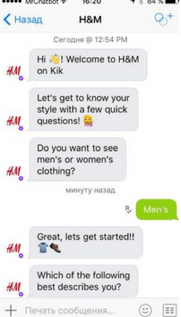
Artificial Intelligence and Machine Learning
Consumer demands and expectations are rapidly changing. And to keep up with that businesses have turned to AI and Machine Learning to deliver efficient results. If you are in the food delivery industry, then AI and ML will help you streamline delivery time, enhance growth, optimize the supply chain, and more.
Step 8: It’s Time to Launch!
You have the end-product ready in your hand. Now it’s time to announce your app’s arrival!!
3 Common App Development Mistakes You Must Avoid
Skip Making an MVP
An MVP (Minimum Viable Product) emphasizes on developing a mobile app with features that are unique and essential. But it requires enterprise to involve real users in the development process to improve the mobile app based on real-time response from the users. This will help you understand customer expectations, reduce development cost, and enhance the app’s functionality.
Not Having Cross-platform Strategy
People still stick to developing an app on a single platform and this is a very common mistake. With the help of advanced cross-platform tools, you can build applications for both Android and iOS. Cross-platform strategy will save your time and efforts, and will give a seamless experience across all platforms.
Adding Excessive Features and Functionality
While advanced features are great for your app but remember that they will add up to the cost and development time. For starters, it is advisable to create an app that serves the basic purpose and eventually introduce new functionalities.
Now, how to save yourself from these errors? Well, partnering with an experienced team can help you build a successful app much faster.
Now that we have discussed everything to build an app, let’s talk about how you will ensure consistent growth of your business once you launch the app. Any business would need below parameters to grow and sustain into the market in such a touch yet optimistic environment.
Customization based on unique business cases:
Customization is the best business strategy. Netflix, for instance, will show customized recommendations according to your preference. From Spotify to Nike, personalization is everywhere. According to Epsilon, 80% of consumers are more likely to make a purchase from a brand that provides personalized experiences.
Product customization is one way to increase customer experience and drive customer loyalty. You can utilize this strategy to make your customers happier. Suppose, you have an on-demand delivery app for t-shirts, then you can let your customers design the t-shirt by choosing a color, adding a quote, or an image. For a food delivery app, you can provide personalized menu recommendations with the help of AI.
Industry best UI/UX:
The aim of mobile app UI design is to provide easy, effective, and enjoyable interaction between the user and the app. While UX design aims to turn users into loyal customers by providing a positive user experience. There are some prime components that you need to consider when designing a mobile app:
- Information Architecture to offer easy navigation.
- Interaction Design which includes colors, fonts, icons, images, etc.
- Usability to determine if the user is getting the information he is looking for.
- Wireframing to test the app’s features and usability.
UI/UX mobile design will help you attract users, create a good first impression, and drive loyal customers in the long run.
Marketing
The marketing strategy needs the same amount of time as building an app. Start marketing long before the launch. This will create anticipation and enthusiasm. You can create a landing page announcing the arrival, or spread a word on social media. You can even start a blog on your website to share information and keep people updated. Post-launch, you can promote your brand by offering discounts, growing subscription lists, optimizing websites, reaching out to influencers, encouraging customer ratings, making informational video content, and more.
You have an idea for an on-demand delivery app? We can help you build a fully-functional app.
